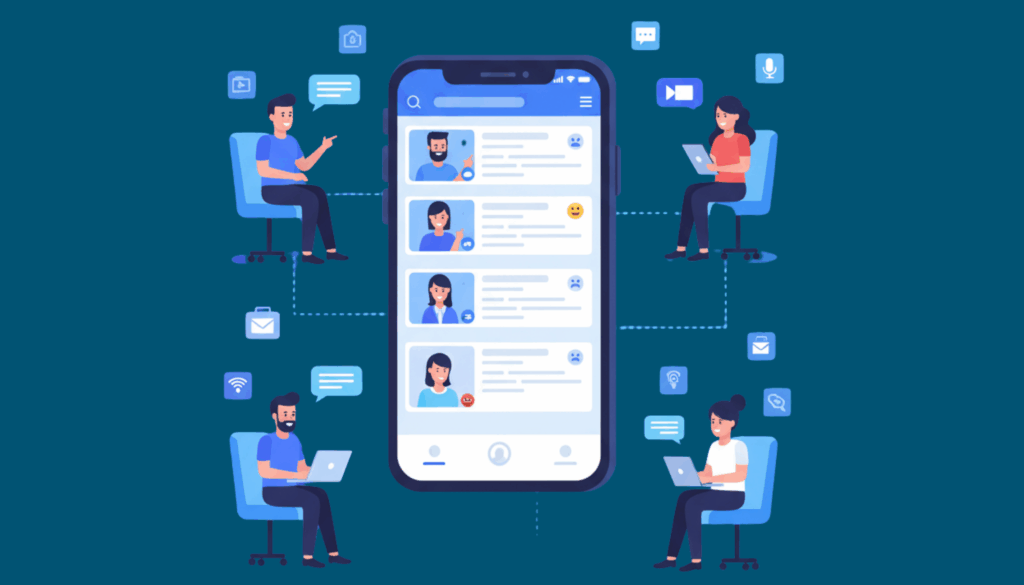Why distributed teams struggle with connection
Work doesn’t happen in one office anymore. From retail associates in stores to field reps on the road to hybrid teams across time zones, today’s workforce is more distributed than ever. Flexibility is a strength—but it also makes communication harder.
Emails, intranets, and video calls can’t bridge the emotional or logistical gap. They’re too static, too siloed, and too overwhelming to sustain engagement. Distributed teams need tools that feel alive—immediate, accessible, and interactive.
As one Yapp teammate said: “When employees feel connected, geography stops mattering. But when tools don’t work, distance feels bigger than ever.”
A connected culture doesn’t just happen—it’s built intentionally. The right communication platform can turn miles into moments, giving teams a shared sense of purpose even when they’re apart.
What happens when communication tools fall short?
When distributed teams rely on outdated systems, the ripple effects hit both morale and productivity:
- Delayed communication: By the time updates arrive, they’re already outdated.
- Uneven experiences: HQ stays informed, while remote and retail staff are left behind.
- Low morale: Disconnected employees lose motivation fast.
- Missed opportunities: Great ideas get stuck locally instead of spreading company-wide.
Cole Haan lived this reality. With store associates across the U.S., HQ struggled to keep everyone aligned. Email updates and printed materials created inconsistent experiences. By building an internal app with Yapp, Cole Haan centralized training, recognition, and campaign content—connecting hundreds of stores through one branded hub. The change was immediate: associates felt more informed, supported, and inspired to represent the brand consistently.
Verizon faced similar communication gaps during its large-scale training programs. Hundreds of employees attended regional events, but logistics relied on paper-heavy systems. After shifting to Yapp’s mobile event apps, Verizon improved communication, boosted participation, and reduced event costs by 10%.
These examples show that when communication tools evolve, culture follows.
How internal apps create connection and inspiration
The solution isn’t more emails—it’s smarter, more human communication. An internal communication app or mobile event app repurposed for employee engagement gives distributed teams what they need most: clarity, consistency, and connection.
Here’s how internal apps make it happen:
- Instant communication: Push notifications deliver updates immediately to everyone.
- Shared resources: Training guides, policies, and videos live in one searchable hub.
- Two-way engagement: Polls, feedback forms, and social feeds let employees contribute, not just consume.
- Recognition at scale: Shoutouts and achievements get celebrated company-wide.
- Cultural alignment: Consistent messaging ensures every employee connects to the brand mission.
A Yapp teammate shared: “The best part is watching employees engage with each other across regions. Suddenly it’s not just communication—it’s community.”
When employees can interact instead of simply receive, communication becomes a source of inspiration. They see wins across departments, learn from each other, and feel part of something larger than their own role.
And as reinforced in our guide to transforming internal communication, mobile-first platforms outperform static systems by over 60% in adoption and engagement.
Empowering leaders and local voices
Internal apps don’t just connect teams—they amplify leadership communication. When managers, executives, or team leads can post updates, recognize wins, or share reflections directly in the app, employees hear one voice across all locations. That visibility builds trust.
At the same time, local empowerment thrives. Store managers, regional leads, and field reps can post localized updates, celebrate wins, or share creative solutions. This balance—top-down alignment with bottom-up participation—creates a culture that feels both unified and authentic.
Recognition posts, training recaps, and campaign stories become daily touchpoints that strengthen belonging. Teams no longer feel like distant satellites—they feel like part of one connected organization.
How to roll out an internal app for distributed teams
If you’re ready to close the communication gap between HQ and the frontline, here’s a practical roadmap:
- Identify communication gaps — Map where information currently stalls or gets lost.
- Choose a no-code platform — Platforms like Yapp let non-technical teams create and update content fast.
- Pilot with one region or department — Gather early feedback before scaling.
- Incorporate interactivity — Use polls, recognition posts, and Q&A to build engagement.
- Scale gradually — Expand the app to new teams, track analytics, and iterate your approach.
Both Cole Haan and Verizon followed this model—and the results went beyond operational improvements. Employees began sharing more ideas, engaging with peers, and feeling a stronger connection to company culture.
A Yapp employee explained it best: “When communication is centralized and interactive, employees stop feeling like they’re working for the company and start feeling like they’re building with it.”
Connection is culture
Distributed teams don’t have to feel disconnected. When you make communication easy, recognition visible, and participation effortless, you transform distance into unity.
Internal apps bring culture to life—making every employee part of the same conversation, no matter where they log in. The result is a stronger sense of belonging, lower turnover, and a team inspired to deliver their best work every day.Your employees deserve more than email threads and outdated portals. Give them a connection that inspires.
Build your internal app today and see how Yapp helps distributed teams stay aligned, engaged, and motivated.









